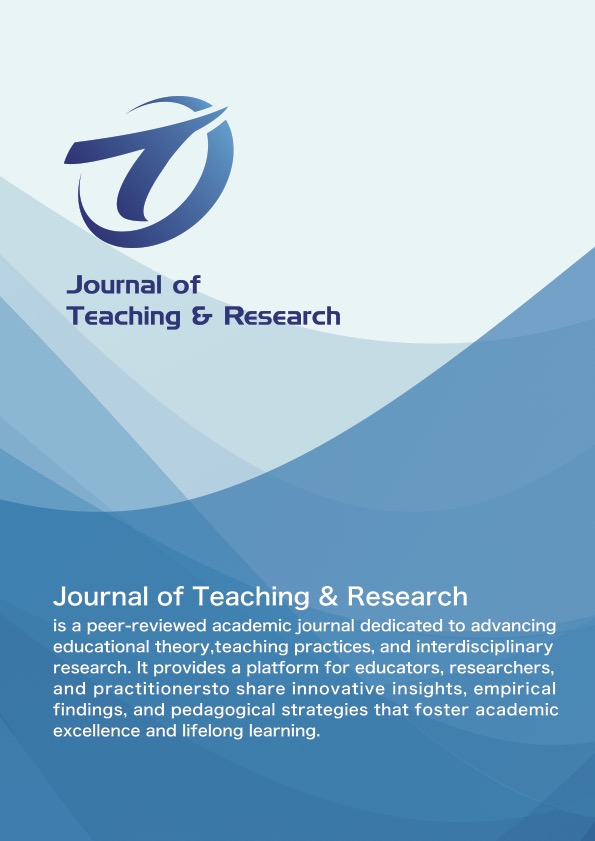Exploring the Integration Path of Professional and Innovation-Education in Business Disciplines at Application-Oriented Universities from the Perspective of Triple-Chain Collaboration
DOI:
https://doi.org/10.65170/jtr.v1i1.13Keywords:
Triple-chain collaboration; Industry–education integration; Scientific–educational integrationAbstract
Based on the theoretical framework of industry chain–innovation chain–education chain collaboration, this study investigates the integration path of professional education and innovation-entrepreneurship education in applied business disciplines at higher education institutions. Using a questionnaire survey, it analyzes key challenges faced by frontline teachers in practice. The main issues include the disconnection between the education chain and the industry chain, the fragmentation between the innovation chain and the education chain, and the absence of a collaborative platform that links the triple chains. To address these problems, this study proposes a systematic optimization path of demand orientation-capability reconstruction-ecosystem co-building. Specifically, it suggests aligning with industrial demand to precisely match industry and innovation needs, promoting the integration of scientific research and education to drive the transformation and application of research outputs, and co-building an open and collaborative ecosystem that evolves from a closed loop. This study aims to provide empirical evidence and practical guidance to solve structural contradictions in business talent cultivation in the digital economy era and to support the reform of business education under the national strategy of building a strong education system.
References
1. Gao, Y.L., & Ma, Z.Y. (2025). Research on the dilemmas and countermeasures of cultivating economics and management talents in universities under the digital economy. Trade Exhibition Economics, (13), 159–162. https://doi.org/10.19995/j.cnki.CN10-1617/F7.2025.13.159 DOI: https://doi.org/10.54691/1m537y27
2. Han, Y.X. (2022). Problem reflection and reconstruction of the “integration of professional and innovation education” curriculum system in higher vocational colleges. Jiangsu Higher Education, (12), 122–127. https://doi.org/10.13236/j.cnki.jshe.2022.12.018
3. Li, L.P., & Li, H.F. (2024). Exploration and practice of innovative talent cultivation in digital media technology through the “five-position, four-chain, three-stage” model integrated with professional and innovation education. Computer Knowledge and Technology, 20(25),136–139. https://doi.org/10.14004/j.cnki.ckt.2024.1284
4. Li, X.F. (2022). Research on the construction of a new business practice teaching base in application-oriented universities under the “triple-chain collaboration” background. Educational Informatization Forum, (12), 96–98. https://doi.org/CNKI:SUN:EIIF.0.2022-12-032
5. Liu, J.M. (2018). The broad-spectrum innovation and entrepreneurship education system under the context of mass entrepreneurship and innovation. Think Tank Era, (52),152–153. https://doi.org/CNKI:SUN:ZKSD.0.2018-52-102
6. Liu, L., & Yu, J.J. (2024). The training model and innovative pathways for new business application-oriented talents in the digital economy: A case study of application-oriented undergraduate universities in Jiangsu Province. Journal of Nanning Normal University (Philosophy and Social Sciences Edition), 45(04),154–167. https://doi.org/10.16601/j.cnki.issn2096-7349.2024.04.012
7. Liu, Y., & Zhu, S. (2023). Research on the talent cultivation path of “integration of professional and innovation education” for new business professional clusters. Education Research Monthly, (07), 46–52.https://doi.org/10.16477/j.cnki.issn1674-2311.2023.07.001
8. Shi, L.Y. (2025). Exploration and reflection on the development model of “integration of professional and innovation education” under the background of new business disciplines. Shanxi Youth, (05), 19–21. https://doi.org/CNKI:SUN:SXQS.0.2025-05-007
9. Tan, P., Li, H.T, Yang, Z.N., & Bai, Y.T. (2025). Research on the construction and practice of the “six integrations” system for innovation and entrepreneurship education. Contemporary Teaching and Research, 11(05), 39–42. https://doi.org/CNKI:SUN:DDYC.0.2025-05-009
10. Xu, J. (2025). Research on the construction and practical path of the innovation and entrepreneurship curriculum system for e-commerce majors under the background of “integration of professional and innovation education”. Time-Honored Brand Marketing, (15), 238–240. https://doi.org/CNKI:SUN:LZHP.0.2025-15-078
11. Yang, G.F. (2019). Exploring the training path for new business professionals in higher vocational colleges under the digital economy. Chinese & Foreign Entrepreneurs, (23), 213. https://doi.org/CNKI:SUN:ZWQY.0.2019-23-174
12. Yang, K., Ning, Y.Y., Chen, S.H., & Xu, W.J. (2025). Exploration of university curriculum system reform under the background of industry-education integration: Taking the physics major as an example. Journal of Higher Education, 11(S2), 121–124. https://doi.org/10.19980/j.CN23-1593/G4.2025.S2.030
13. Yao, S.Z., Wang, C.T., & Tian, H.S. (2020). Problems and pathways in the construction of innovation and entrepreneurship education faculty teams in application-oriented universities. Education and Vocation, (13), 69–74. https://doi.org/10.13615/j.cnki.1004-3985.2020.13.011
14. Zhang, L.Q., & He, T.T. (2025). Research on the integration path of professional education and innovation and entrepreneurship education in international economy and trade major: Based on the “broad-spectrum” innovation and entrepreneurship education system. Modern Business Trade Industry, (16), 64–67. https://doi.org/10.19311/j.cnki.1672-3198.2025.16.019
15. Zhang, Y. (2021). Deepening the “industry-education integration and university-enterprise cooperation” model to cultivate practical talents for enterprises. New Course Teaching (Electronic Edition), (14), 155–156. https://doi.org/CNKI:SUN:XKJX.0.2021-14-079
Downloads
Published
How to Cite
Issue
Section
License
Copyright (c) 2025 Ming Feng

This work is licensed under a Creative Commons Attribution 4.0 International License.








